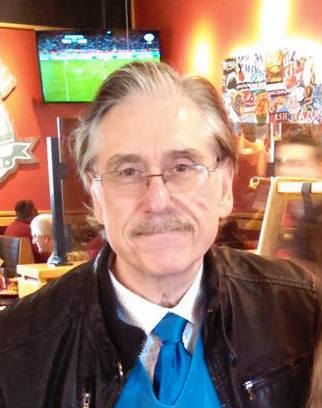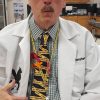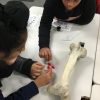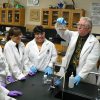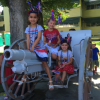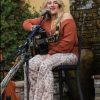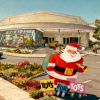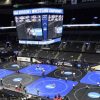InterView
by Chris Murphy
Back to School with Dave Menshew
I love smart people. I want our leaders to be smart people, we need smart people making the key decisions that affect our future, our planet and our people. Yes friends, I love science. Just how to we make sure that there are generations to come of smart, thinking, analytic people to move our planet forward so we have a future. There is amazing stuff happening here in Modesto where students are taught to think critically and understand the world around them. It is exciting to meet Dave Menshew, teaching at the innovative Biotechnology program at James C Enochs High School. Yes, we have a CSI training grounds here in Modesto USA.
Dave was born in Lodi and raised in Modesto from 2nd grade through MJC. He is the son of one of my favorite people ever, Al Menshew, former executive at Gallo Glass (and respected Shriner and Clamper elder) and Vera Menshew (deceased). He went to school at El Vista, Wilson, LaLoma, Downey, graduating in 1972. Dave has Degrees from MJC, CSU Stanislaus, Chapman, Merced College and working on his doctorate at Brandman. His wife Sharon work for Stanislaus County.. So let’s meet Dave:
ModestoView: Why are STEAM, STEM and Biotech programs so important?
Dave Menshew: STEAM, which is the integration of the art into the study of science, technology, engineering and math. The first is something I have said for years, without the arts, the scientists won’t have anything worth researching. Shaw said it best, “without art, the crudeness of reality would make the world unbearable. It’s the arts, the music, the sculpture, the paintings the plays and other endeavors that make us human and hopefully give us the understanding of science that will lead us in the direction of its best use for humankind. STEM is all the rest of science for me, that allows us the tools and the option to make people’s lives better. Biotechnology, as it has been applied at Enochs High School, has resulted in many young people becoming engaged in the sciences while giving them solid lab skills that they can apply in future coursework. At the same time, it has helped them develop habits of mind that have served them well in their jobs, colleges and universities.
MV: How do we engage the next wave of students to embrace the scientific method?
DM: The scientific method as taught in textbooks isn’t really how science is done. I have seen that in all of my time in a number of research labs. The formalized approach is fine for starters, but I have found that just looking for things that capture students’ interest, such as CSI and Zombies, has worked well for us. We try to build off their existing interests and channel their motivation. We will engage the next wave by being aware of their interests and designing learning opportunities that capture them.
MV: Do you feel we have to show the possibilities of what can happen to interest kids in math, like the drag coefficient calculation that would lead to F1 car design, or the rebound calculation you would use to design a full suspension mountain bike?
DM: I think that the math associated with the physics you have described should not be frontloaded in the learning experience. Show them the cars doing the activities that illustrate drag coefficient and elastic rebound (when cars hit walls or each other). Engage and add the math. Once you have them interested, the move to the theory.
MV: What myths do you think need to be overcome in this field?
DM: In the STEM field in general, there are many myths that exist. The arguments that swirl around evolution, global warming and other hot topics are ways into the dialog. I would again, use the heightened interest these things create in students, and then move to what the data says. I have NO issues with students who want to challenge the status quo in science. I tell them that if they choose not to believe in a theory, then I expect them to educate themselves to be articulate advocates for their position. Challenging science teachers and scientists is an excellent way of engagement.
MV: What would help you the most to develop a more successful program at Enochs High.
DM: I think we did. Look at the four papers in international media published on our work, at the accolades the students have earned, and the many success stories we hear back from our graduates. We have former students recognized by Forbes and working on doctorates. We have many going on to colleges and universities, and others serving our nation with distinction in the armed forces. This approach is successful. What would help it be more so is greater involvement of the parents. I am very proud how the students have stepped up, I would love to see the parents come out and join us in our activities.
MV: What is one of your biggest surprises when teaching kids in this field?
DM: I am constantly amazed at how adept they are at problem solving. We do many things both in and out of the classroom. Our students went out and did 23 public science events at many venues including the State Fair, a university campus, many middle and elementary schools, and especially into areas with high poverty. They enthusiastically took on these challenges and delivered quality hands-on core science concept learning opportunities for kids of all ages.
MV: What can parents do to encourage science and biotech thinking when kids are little?
DM: We have actually done some research, obtained a grant, and field-tested a new facet of our program called Cocina Ciencia or Kitchen science. Parents, who cross our paths at some of the events our students are working at, get the chance to participate and take home science to teach to their kids. Alternatively, we encourage to search the Internet to find simple, low or no-cost things they can do. Those who contact our program will be given assistance
MV: Who were your mentors and inspirations when you were young?
DM: Mr. Wizard. I even got a signed picture of him before he passed to that big laboratory in the sky. I also was captivated by pretty much anything science related in the 1950’s when American was responding to the Sputnik event. As I got older, there were many science teachers and others who encouraged me to study science. Perhaps the most influential, were Dr. Doug Kain of Merced College who challenged me to create a biotech program, and Dave Cooper, former director of curriculum development for Modesto City Schools who made the Enochs Program a reality.
MV: What do you enjoy the most about teaching?
DM: Getting the chance to help young people follow their dreams. As I tell them each year, “I get paid to help give you the tools you need to be successful. Go find something you love and get someone to pay you for doing it I did.”
MV: If you had all the budget you needed and were school king for a day, what would you do?
DM: We need to engage more kids of all ages in science, with an emphasis on the young women in our population, Hispanics and African Americans. We have great-untapped talent in those three groups, and as a nation are missing the chance to benefit more from their contribution. We need to do all we can to make science a viable option where it may not be presently. I have been working in that direction for 23 years and plan to continue until checkout time.
MV: Describe your perfect day in Modesto?
DM: Far less than 100 degrees, no sirens on the way to the gym and back, and no one acting the fool in traffic. End the day with a margarita with friends at one of our many fine restaurants (Rivets if I can mention names.)
MV: Beatles or Stones?
DM: Now this is creepy. I was a hard core Beatles fan way back in the early 1960’s. I played in a band and we did some Stones, but I was not a fan. As I get older, I like the Stones more and more. Not sure what that means. Perhaps it’s the longevity. We are down two Beatles but still have all of our Stones.


